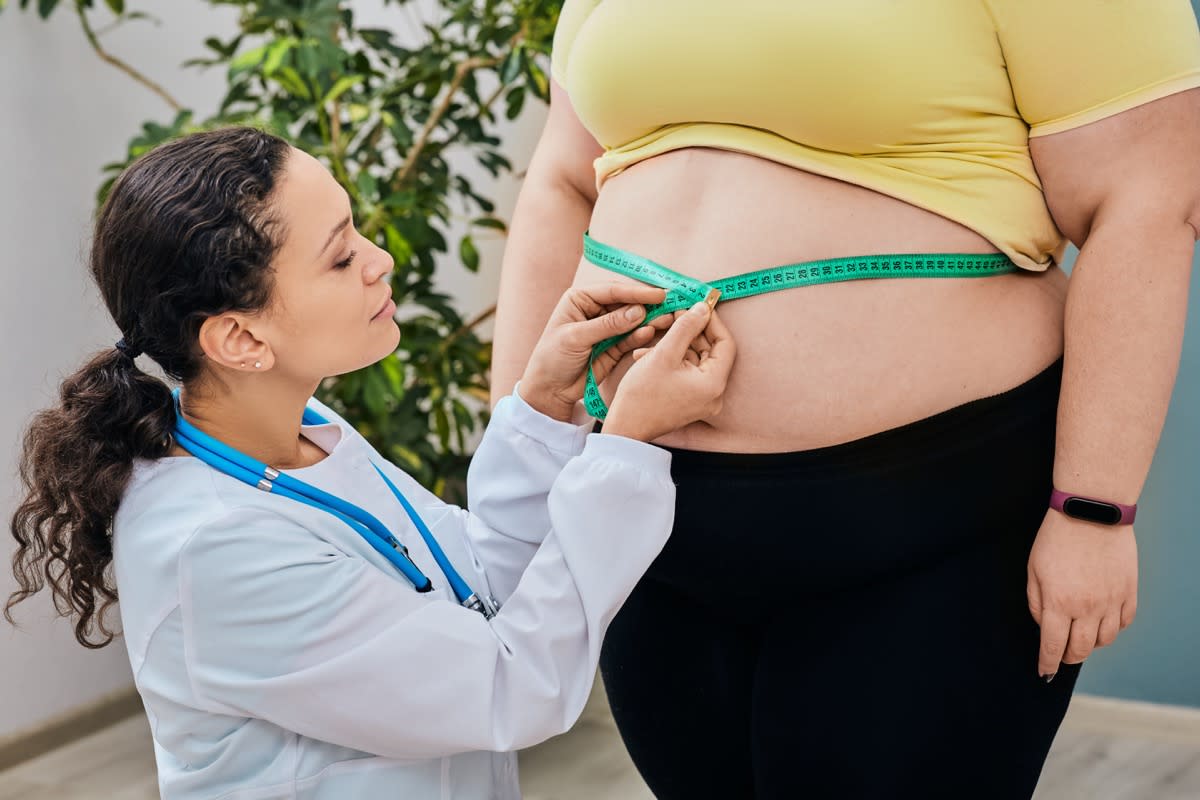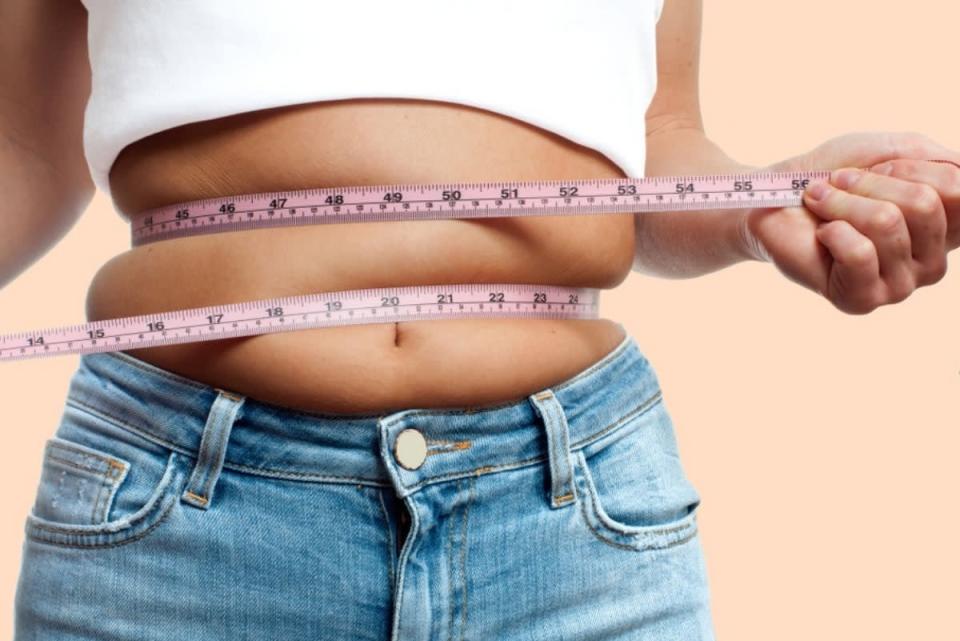
How to Lose the Fat Inside Your Belly, Says Physician
Table of Contents
Do you ever feel that despite your best efforts, you can’t seem to lose your stubborn belly fat? Do you suffer from elevated blood sugars, high blood pressure, or feel sluggish all the time? I am a doctor who focuses on weight loss and disease prevention, and when I help people decrease their belly fat, it affects more than just their pant size. By reducing your belly fat, the dangerous visceral fat in your belly, you can increase your energy, decrease the inflammation in your entire body, and reduce your risk for many of the most common chronic diseases that plague our population. Read on to find out how to lose fat underneath your belly—and to ensure your health and the health of others, don’t miss these Sure Signs You’ve Already Had COVID.
1
Yes, You Can Reduce Your Visceral Fat and Improve Your Health

Visceral fat is the term for the fat around your belly— but it is not the fat that you can pinch. Visceral fat is deeper, covers your abdominal organs, and is problematic. It was once thought that fat cells were just storage cells, but doctors now know that our visceral fat cells actually produce hormones and pro-inflammatory proteins, which have been linked to the development of type 2 diabetes, heart disease, and many other chronic diseases. There is no way to specifically target visceral fat, but by decreasing your overall percentage of body fat, you can reduce your visceral fat, and subsequently decrease inflammation and improve your health.
2
Eat This Much Fruits and Vegetable

Eat at least 5 servings of fruits and vegetables a day— eating more servings is even better. When trying to lose weight or burn fat, a common tendency is to focus on deprivation, which is not sustainable. Rather than focusing on what not to eat, try instead to eat more plants. By eating more fruits and vegetables, you will automatically crowd out packaged and processed foods— which are nutrient poor and calorie dense. Not only will eating this way help you lose weight and body fat, but it will provide you with more nutrients, decrease your risk for chronic diseases, and help boost your energy.
RELATED: Doing This After Age 60 is “Unhealthy,” Say Physicians
3
Eat More Fiber

When we eat food that is high in fiber, it keeps us feeling full for longer, but it also helps to decrease our body’s insulin spikes, so we can burn fat. Not only that, but eating fiber has numerous other health benefits, including decreasing our blood sugars, boosting our gut microbiome, and decreasing cholesterol (just to name a few).
The American Heart Association recommends eating 25-30 grams of fiber per day, and there are significant health benefits to consuming even more than that. Unfortunately, the average adult in the United States only consumes about 15 grams of fiber per day.
Here are some ideas to add more fiber into your day:
Try adding a serving of berries with your breakfast. Aim to eat a serving of beans or lentils every day. Try to eat more whole grains, rather than refined grains.
RELATED: The #1 Sign Your Blood Sugar is “Way Too High”
4
Stop Eating Sugar

Try a sugar detox. If you look closely at labels, you will see that sugar is in almost everything: cereal, pasta sauces, bread, and many beverages. Even whole grain breads that seem healthy, often have a lot of extra sugar added.
For most of us, our bodies are addicted to sugar, and our brains are ultra sensitive to its effects. In studies, researchers have found that for rats, sugar is actually more addictive than cocaine. Our excessive sugar consumption is driving our cravings, promoting inflammation, and causing us to store fat.
See how you feel without sugar for a couple of weeks. This will be difficult at first, but will get easier with time. If you are craving sugar, try eating a piece of fruit, drinking a glass of water, or taking a hot shower instead.
RELATED: Signs Your Gut is “Unhealthy,” Say Physicians
5
Go Easy on Snacks

Eat 3 meals a day and minimize snacking. If you do want a snack, avoid typical snack foods like crackers, cookies, and chips, and instead eat a piece of fruit or a handful of nuts.
Over the last 40 years, the patterns of eating and snacking behavior in the US has changed, and rather than eating 3 meals a day, many Americans skip meals and snack all day. The timing of our eating is related to our metabolism, obesity risk, and cardiovascular risk, and when we are snacking around the clock, we are not giving our bodies a chance to burn fat.
Instead of snacking frequently and missing meals, try to minimize snacking, and eat 3 set meals a day. Meals should consist of a mix of fruits and vegetables (1/2 of your plate), lean or plant based proteins (1/4 of your plate), and whole grains (1/4 of your plate). Then, after dinner, skip the late night snack, and don’t eat again until breakfast.
6
Walk For This Amount of Time

Take a brisk walk for at least 30-60 minutes a day. More exercise is even better.
Exercise is often regarded as punishment for eating. But in reality, the benefits of exercise are so much more than just “working off” your food.
Our metabolism, body weight, and fat stores are regulated by a complex balance of hormones— and our physical activity, sleep and stress levels directly affect this delicate balance.
Not only will increasing your physical activity boost your metabolism and help you burn fat, but it will improve your mood, decrease your stress, and help you sleep, which are all essential for losing fat and keeping it off.
7
It Doesn’t Have to Be Painful

Losing your belly fat does not need to be difficult or stressful. As you make these changes, please remember to be kind to yourself and to practice self compassion. Rather than focusing on dieting and deprivation, a better strategy is to make sustainable lifestyle changes for the long term. As you make these lifestyle changes, and notice your belly fat shrinking, you will likely notice other changes too, including increased energy, a clearer complexion, an improved mood, and better digestion. These improvements in your quality of life are just the beginning, as you will also be decreasing your risk for chronic diseases, and helping to add healthier years to your life. And to protect your life and the lives of others, don’t visit any of these 35 Places You’re Most Likely to Catch COVID.
Dr. Ritu Saluja-Sharma MD is a board-certified physician in Emergency Medicine and Lifestyle Medicine, an integrative health coach, and the founder of Head Heart Hands.
